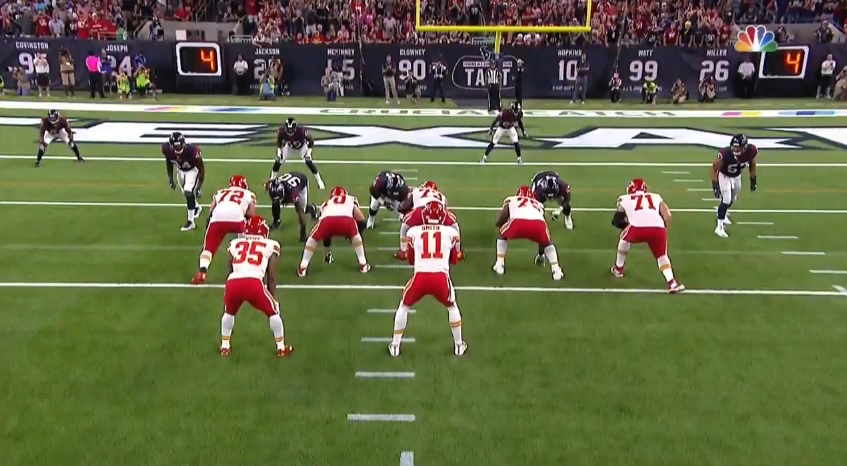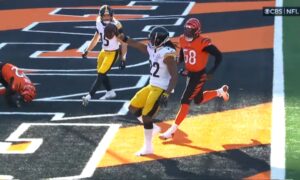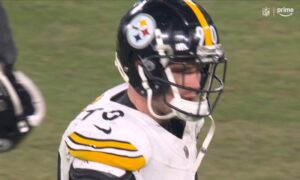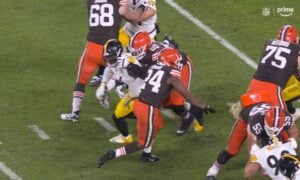Fact: Success in the red zone is one of the biggest reasons why teams win or lose on a regular basis. You probably already knew that, but what you might not know is how exactly teams prepare to win so close to the goal line.
If you want to know how to coach football, you need to understand the different tactics teams use in different areas of the field. So let’s talk about some things that go into red zone strategy.
Basic Red Zone Strategy
The red zone is actually made up of a few different areas that each require their own unique approach to play calling and strategy.
The reason is simple: It all comes down to spacing. The closer the offense gets to the goal line, the less space they have to work with, and just as importantly, the less space the defense has to worry about covering.
Put another way, you can’t call a 50-yard bomb to your best receiver when you’re sitting at your opponent’s one yard line.
That’s an extremely obvious example, but it illustrates the kinds of problems an offensive coordinator faces when he’s putting together the game plan for the red zone.
The defense isn’t worried about getting beat deep, the safeties can get a lot nosier in the run game, and against average or worse quarterbacks the secondary will just sit down on the goal line and make the offense either throw a perfect pass into an impossibly tight window or run it up the middle into the teeth of that defense.
NFL coaches understand this, and that’s why they all slice up the red zone into even smaller pieces. For example, a coach may have a group of plays for 20-16 yard line, the 15-11 yard line, the 10-6 yard line, and the 5-1 yard line. Each coach has his own preferences, and everyone does it a little different.
For the record, I have no inside knowledge of how Andy Reid and his staff like to divide up the red zone when they’re game planning during the week, but through enough film study you can start to get a feel for what Kansas City likes to do.
The 7 Yard Line
In this post, we’re going to focus specifically on the red zone plays the Chiefs like to call from the 7 yard line all the way to the 1.
Why start with the 7 yard line? Again, it’s all about the spacing.
The geometry and spacing of the field changes so much the closer you get to the goal line, and once an offense reaches the opponent’s 7 yard line (or +7), it now has a little over 3x as much horizontal space to work with as vertical space (53 1/3 yards wide compared with only 17 yards deep).
As a result, an offense has to run different sorts of plays than they would if they were on their own 40 yard line, or even at the +25 yard line.
Yes, it’s true that you’re very close to the end zone, but unless you make the defense cover the entire width of the field, you’ll find yourself settling for a field goal much more often than you’d like.
So let’s talk about the kinds of things Andy Reid likes to do in this area of the field, and more importantly, why.
Today we’ll discuss four different kinds of plays the Chiefs have run from the +7 to the +1 yard line under Andy Reid’s tenure the past few seasons. This is not meant to be an exhaustive list, but it’s a few of the more common themes you’ll find when you study this offense.
1. Using the QB in the run game
As an offense, you’re already boxed in tight in this part of the field, so if the quarterback is never a threat to run, you’re telling the defense that they only have to worry about defending 10 guys. After all, even Peyton Manning occasionally took off around the corner on the QB keeper.
This is where Alex Smith’s spread background comes in handy. He doesn’t need to do anything fancy, just present a credible threat to run with the ball. If the defense doesn’t respect it, he needs to make them pay, and that’s exactly what he’s capable of doing.
Play 1 – TB Flips Sides to Zone Read Keeper
One of Andy Reid’s staple plays in this offense is running the zone read play from formations like this. The defense has to account for the inside zone, the QB keep, and the bubble screen (or some other pass concept) from the three receiver side.
Defenses have specific rules on how to defend the play, and a lot of it is based around which side of the formation the back is lined up in the backfield. Each defender has a specific player or gap they’re responsible for depending on where the option threat is coming from, so the last-second switch by the back forces the defenders to flip their own option responsibilities with very little time to adjust. The defense is caught out of position here so Alex Smith keeps it up the middle for a score.
Play 2 – TB Motion from Empty to Zone Read Keeper
Here’s another variation on the same play, only this time the back starts out wide in an empty set. Alex Smith takes the snap and takes off for the pylon.
If Alex Smith gets a look he doesn’t like to the left side when the TB is out wide, he can check to something else, but in this case the defense gives him exactly what he wants.
2. Using shifts to create confusion on defense
This is something a lot of teams do, but Andy Reid makes a point of creating a lot of movement down near the goal line. As valuable as it can be to create confusion and outnumber the defense in the middle of the field, it’s even better when you’re only a few feet from six points.
Play 1 – “Explode” Shift to Now Screen to Poe
In one of the most memorable trick plays of the 2016 season, Kansas City comes on to the field with “Jumbo” personnel that includes defensive tackle Dontari Poe lined up as a fullback. Instead of just running the ball downhill predictably, the Chiefs shifts to a 4×1 bunch set where Poe is set up behind 3 blockers.
(This play could’ve just as easily been categorized as a trick play, but don’t worry, we’ll get to more of those later.)
Oakland actually does a good job here of matching Kansas City in terms of numbers, but the Chiefs have a huge size and weight advantage, and Poe catches the ball and bowls over everyone across the goal line for the score.
This is a great way Kansas City keeps things unpredictable for their opponents, both in this particular game, and anyone else who happens to break down the film and analyze their red zone attack. Just by throwing in this one trick play out of jumbo personnel, defenses can no longer “sell out” against the run when Kansas City brings on so many big guys down near the goal line.
Play 2 – Fake TE Trade Shift & FB Motion to Outside Zone Fake Reverse
Kelce acts like he’s about to switch sides when the fullback goes in motion to the right side. The offense ends up in a 3×1 set where the TE and FB are both off the line in perfect position to block for the outside zone play.
One interesting result of this shift is that when Kelce starts to move to the right and the returns, he actually widens his original alignment, forcing the defensive end across from him to do the same. As a result, he opens up a wide gap in the formation where the fullback will end up just before the snap, and he also creates a bigger gap in the defensive front, and that’s exactly where the tailback ends up running for the score.
3. Using the threat of the jet sweep to stretch the defense horizontally
Like we talked about earlier, there’s a lot more horizontal space to work with down in this area of the field. If you can’t use the threat of the long bomb to get the defense to back off and create space underneath for the pass, you have to use the threat of jet sweep and other perimeter plays to open up space for the run up the middle. Here’s a couple of ways Kansas City does just that.
Play 1 – Double Motion Jet Sweep Boot Delay Follow
Here’s an example that should look familiar to Steelers fans, it’s a play from last year’s Divisional Playoff game. The game was on the line, and the Chiefs needed at least 2 yards.
Once again, the fullback moves in motion first, resets, and then Tyreek Hill comes down the line in jet motion. Alex Smith takes the snap, opens up to fake the jet handoff to Hill, then boots to the right side to read the “delay-follow” concept.
The idea is that the 1st player may be open (the tailback) but even if he isn’t, he should take the underneath defenders with him and open up space for the guy coming in behind him (the fullback).
And that’s exactly what happens.
Smith actually has a 3rd and 4th option on this play if he needs it. Travis Kelce blocks for the jet fake then turns around and hangs back, careful to keep a good amount of spacing between himself and the other two routes. Finally, if no one is open, Smith can take off and try to pick up the two yards with his feet.
In the biggest play of the season up to that point, Andy Reid made sure his quarterback had as many options available to him as possible.
Play 2 – Jet Twirl Motion Stretch Shovel Option
You’ve probably seen clips of the shovel pass to Travis Kelce from earlier in the season, and here’s another variation of what’s essentially the same play. This time the ball goes wide on the stretch.
The “Jet Twirl” or “Jet Return” motion is able to not only force the defensive front to hesitate, but also gets the safeties to bite on the jet fake in the other direction.
At this point it turns into a race to the edge, and it gets Kansas City to the doorstep of another touchdown just short of the goal line.
4. Using trick plays to score in unpredictable ways
Play 1 – Dontari Poe Jump Pass
Dontari Poe became the heaviest guy in NFL history to throw a touchdown pass when Andy Reid called this play against Denver last year.
Notice all the big bodies on the field for the offense, and how the defense has packed itself in to stop the big downhill run play they think is coming at them. After all, this is a run all the way, right?
Wrong.
Granted, the game was over by the time Reid dialed this one up, but for the rest of the season, whenever Dontari Poe was in on goal line situations, the defense had to be ready for anything.
Poe is no longer with the Chiefs, but as we’ll see on the next play, Andy Reid doesn’t need to use a defensive tackle to do something unconventional on offense.
Play 2 – QB Motion Wildcat Sweep Read
Just when you think you’ve got this offense figured out, Andy Reid goes and throws another curveball at you. Here’s another trick play from the first Denver-Kansas City game last season.
This full house, four-men-in-the-backfield “diamond” set is a favorite of Reid’s in the red zone because of how many different things you can do with it.
Alex Smith starts calling signals, then takes off to the left, leaving Spencer Ware to step up and take the snap. At this point, the defense isn’t sure what to expect, but Ware takes the snap and hands off to Tyreek Hill on the sweep read, and he manages to run it in for a score.
Conclusion
Andy Reid and this Chiefs offense have had one of the most creative and unique approaches to the red zone over the years.
The Chiefs aren’t the only team who use a special set of plays in this area of the field, practically everyone does it. Still, it’s Reid’s willingness to change and adapt to what his players do best, combined with some disciplined amounts of risk-taking, that make them so dangerous near the goal line.








